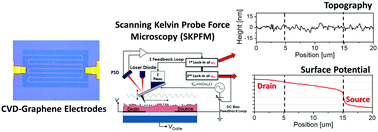Suppression of the morphology mismatch at graphene/n-type organic semiconductor interfaces: a scanning Kelvin probe force microscopy investigation†
Abstract
Contact resistance effects in n-type organic field-effect transistors (OFETs) based on perylene-diimide thin films and monolayer CVD graphene electrodes have been investigated by using Scanning Kelvin Probe Force Microscopy (SKPFM). SKPFM voltage profiles were acquired as a function of the applied drain–source (Vds) and gate–source (Vgs) voltages and in the temperature range between 300 and 360 K. The results were compared with those obtained for hybrid devices bearing contemporarily a gold and a graphene electrode, in order to highlight the specific behaviors of the graphene/organic and gold/organic interfaces. Despite the fact that overall electrical performances of devices based on gold and graphene contacts are fully comparable, the SKPFM analysis demonstrates unambiguously that the physical mechanisms driving the charge injection and extraction phenomena are distinctive based on the electrode type. While for OFETs with gold electrodes, the RC effect is mainly ascribable to the degraded quality of the charge transport in the semiconducting film regions close to the electrodes, for graphene-based devices, it is related to the presence of a Schottky-like barrier at the injecting electrode.



 Please wait while we load your content...
Please wait while we load your content...